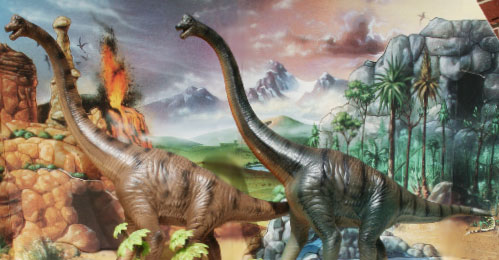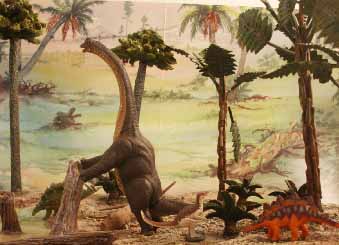
Dinosaur Collector presents
Brachiosaurus
updated 121509 proof 020606 rgk
Brachiosaurs shared the Mesozoic with the giant diplodocids Apatosaurus, Diplodocus and Barosaurus, but they are significantly different from the diplodocids. Brachiosaurus has longer front legs than rear legs, a smaller tail, and the teeth that are very strong and spoon shaped. Its neck is constructed to facilitate high browsing, making the Giraffe the best modern analogue. While brachiosaurs are not the most common animals in any area, they are wide spread; with fossils being found from North America to Africa. The family continues to be important in North America in the Early Cretaceous, when the diplodocids become rare in the fossil record. This pattern implies that the brachiosaurs were less specialized in their feeding habits than the diplodocus family, less specialized feeders commonly are spread wider, less common and are less vulnerable to extinction. They are thought to be related to the titanosaurs that dominated the southern continents in Gondwanaland in the Late Cretaceous.
Ceratosaurus differs from the more common predator Allosaurus in several ways. It had a prominent nose horn, smaller size, and four fingers on the front limbs, and is often reconstructed with horns over the eyes as well. It is usually regarded as more akin to the early carnosaurs of the Triassic. Its relatives, the abeiliosaurs, remained the most common medium sized predators in South America through the Late Cretaceous.
| Brachiosaurs are built to feed high. Trees get taller in the Jurassic as the world gets wetter. Arucaria, Redwoods and Sequoias become wide spread but most of the trees in the Morrison are medium heigth. The most common recombination is for scattered trees and plains of ferns in the wet season. | There are two rival reconstructions of the Brachiosaurus neck. The more artistic S neck has been challenged by biomechanical analysis, which suggests a posture similar to the modern construction crane. Most reconstuctions are based on the African fossils. The North American fossils are larger and torso is longer and legs of even length compared to African finds. | |
 |
||
| Brachiosaurus from the Kinto My favorite Collection courtesy of Healthstones hobbies. Ceratosaurus from the Fame Master 4D Puzzles contributed by the Dinosaur Farm. | Bullyland released the Brachiosaurus in green and brown; only the green is still in production |
| In North America brachiosaur finds are uncommon and solitary. The body is longer and there is less of a difference in length betwenn the fore legs and back legs. | In Africa the brachiosaur finds are more common and in groups indicating they were more social. There is a movement to have the African version sperated as Giraffatitan. | |
 |
 |
|
| Tomi Brachiosaurus, Micro Machine Stegosaurus and Camptosaurus and K&M Stegosaurus. | Center the Scientific 3D Interactive Brachiosaurus with two Starlux figures. The diorama base is a Kinto Georama donation from Toyosaurus. |
Return to Mesozoic Menu